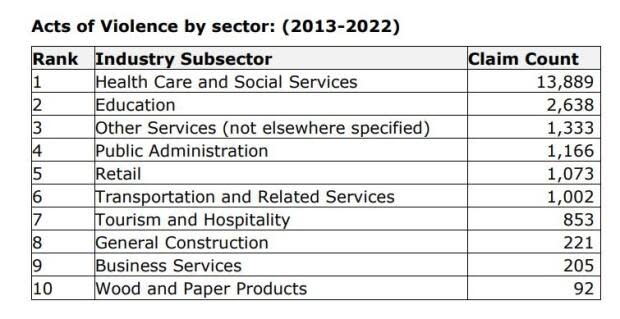Workplace claims related to violence increased by 25 per cent in the past five years: WorkSafeBC

WorkSafeBC is calling on employers to improve their violence-prevention strategies after new data revealed a 25-per-cent increase in workplace claims related to violence in the past five years.
In a report published Friday, the workers' compensation insurer says they counted 2,868 accepted workplace violence claims in 2022, 25 per cent more than the 2,292 accepted in 2018.
The report also lays out the top 10 sectors that recorded the most incidents of violence, with the majority of claims coming from the health-care and social services sector.
Barry Nakahara, senior manager of prevention field services at WorkSafeBC, says risk of violence is an unfortunate reality in some workplaces, and he is urging employers to mitigate those risks as much as possible.
WorkSafeBC defines violence as "the attempted or actual exercise by a person, other than a worker, of any physical force so as to cause injury to a worker."
This includes "any threatening statement or behaviour which gives a worker reasonable cause to believe that the worker is at risk of injury."

"It's clearly not going in a favourable direction and at the end of the day, it's workers who are going home injured and having traumatic experiences from these events," Nakahara told CBC, adding that incidents are preventable and can be minimized.
WorkSafeBC recommends employers develop policy, regularly conduct risk assessments, and update their violence prevention program annually, as well as provide physical barriers, lighting, and public visibility in the workplace.
They also caution that employees working alone may be at greater risk of confrontation, particularly if they are working during late hours.
Calls for security staff in health-care
From 2013 to 2022, the majority of claims came from the health-care and social services sector, with 13,889 incidents of violence — more than five times the number of complaints in the education sector, which came second at 2,638.
Unspecified services, public administration and retail round out the top five sectors counting the highest numbers of workplace claims related to violence.

"I have absolutely been physically hit, kicked or spit on over the course of my career," said Dr. Joshua Greggain, president of Doctors of B.C.
Greggain says staff shortages have exacerbated risks of hospital violence, and it helps to have other staff with the ability to de-escalate potentially violent situations.
"When physicians are trained, they're asked to look after patients and care for them," he said. "They aren't necessarily trained in having to deal with violence or escalating situations."
The B.C. Nurses Union says they continue to call for trained security personnel in emergency rooms, and welcome the province's October 2022 announcement to add more than 300 protection service staff to high-risk health-care settings.
"The problem has reached alarming levels, with reports of assault, verbal abuse and threats becoming increasingly common," the union said in a statement.
"We as health-care workers are there to help people, but sometimes the help is very difficult," said Greggain.
"There have definitely been some escalating scenarios over the last few years as patients are under stress and as the systems are under duress."

